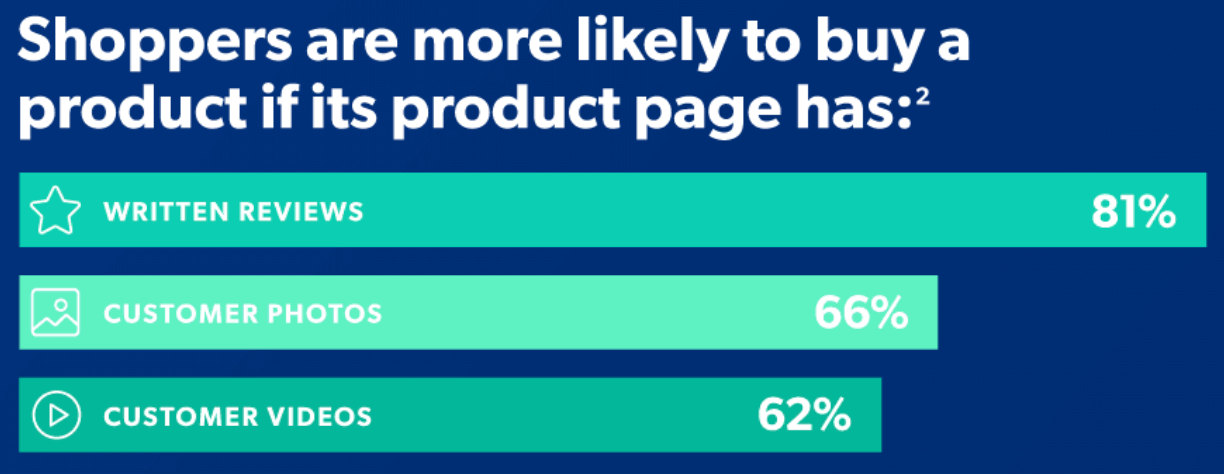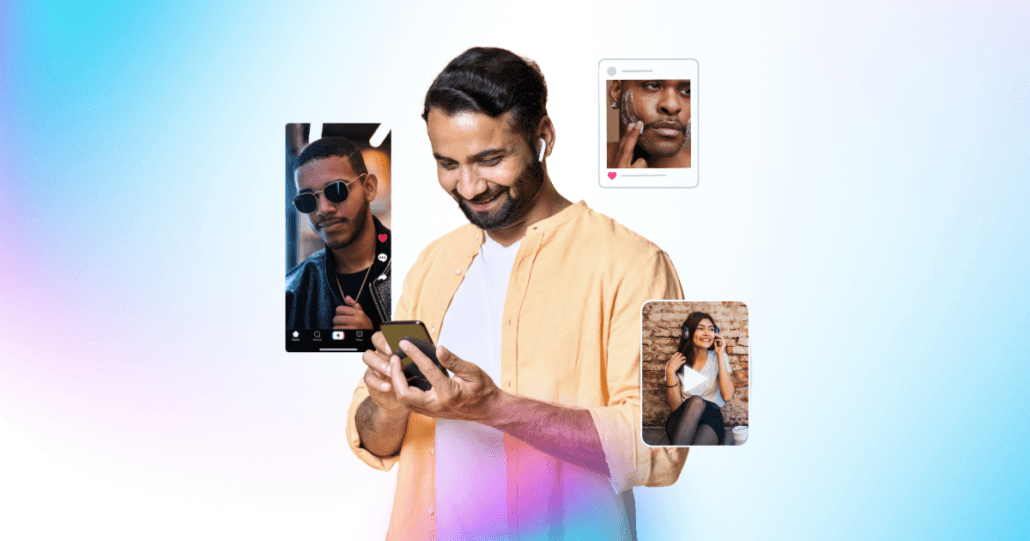January 20, 2023
With the continual rise of new technologies, the influence of social platforms like Instagram and TikTok, and the development of the consumer to consumer commerce marketplace, consumers have come to expect and prefer engaging, visual content when shopping — online and in-store.
In reaction to that, there’s been a noticeable shift in how brands use visual content at the forefront of their marketing and e-commerce strategies.
As a practice, it’s called visual commerce, and the goal is simple: leverage compelling visual content to attract, influence, and convert consumers. Why? Because consumers want it.

But like any marketing strategy, there’s been some confusion around what visual commerce is — and what it’s not. To help clear the air, here’s a guide on how smart marketers think through visual commerce and put it to work to improve the shopping experience.
Defining visual commerce
Let’s start with the basics. Visual commerce is a blanket term that covers a number of ways brands can employ pictures, videos, and even virtual and augmented reality to help consumers learn about and connect with their products and brand.
Popular visual commerce strategies include:
- Building out rich product pages with compelling galleries of product photos, videos, and in-action shots for an overall exceptional e-commerce experience
- Making visual content searchable with the right descriptions and tags to help consumers easily search and discover products on your site
- Playing around with experiential marketing techniques like AR and VR to give shoppers the experiences they crave
- Employing a social commerce platform, so shoppers can shop directly on social
- Bringing visual user-generated content from social media onto your digital shelf
- Packing your content supply chain with authentic, visual content that inspires purchases across every touchpoint
In short, visual commerce uses visual content to guide consumers through their shopping experience, echoing social platforms like Pinterest.
And it works. From YouTube to Instagram, the internet is a visual place — and that’s in large part because humans are too. According to MIT, more than half of the human brain is dedicated to processing visual information. What’s more, people process pictures 60,000x faster than text on average.
In the last few years, the retail industry has come to understand the power of visual content, and the best brands have developed ways to include visual commerce at every stage of the shopper journey — from awareness to conversion.
Why brands are using visual commerce
Like the many examples of visual commerce, there’s a variety of compelling reasons why it works. But it comes down to three main things:
- Customer experience
- Personal, peer-to-peer connection
- Authentic social proof
Making visual content the centerpiece of the e-commerce experience helps close the gap between product and consumer and between in-store and online.
What’s more, visual content elicits the more emotional, personal content that today’s consumers crave, allowing your brand to build an authentic connection with them. There’s no better way to foster this connection than through social media and community content.
Social media has had a big effect on marketing and e-commerce. You can call visual commerce a revolution in e-commerce marketing, but it’s really just the logical next step for an internet that’s increasingly visual and social.
TikTok and Instagram have billions of users combined, creating new, genuine content every day. And much of this content comes from brands and their customers. What’s more, 69% of shoppers have been inspired by social media to make a purchase.
Visual user-generated content
Brands can (and should) use these influential platforms to leverage their own visual content and discover and engage with compelling content from customers.
Photos and videos from customers — called user-generated content (UGC) — have become a big part of visual commerce because it provides the social proof other consumers need to make a purchase. According to our recent Shopper Experience Index of 7,000 global shoppers, 53% of respondents say UGC makes them more confident in their purchasing decisions than professional photography. Another 40% say UGC makes them more likely to buy a product from an ad.
As consumers, we turn to other consumers for reassurance — whether that’s a product review or a social post showing a product in action. The smartest brands realize this and include visual UGC across their marketing mix — on social media, on product pages, in shoppable galleries on their website, and in email marketing. Essentially, anywhere and everywhere consumers are.
Whether as a way to share branded visual content or as a way to discover customer content, social media provides the optimal channel for visual commerce.
How brands use visual commerce to drive e-commerce sales
There’s dozens of ways to make visual commerce drive e-commerce sales. But there’s three common strategies all successful brands use.
1. Put visual content to work on product pages
One of the best ways to create an exceptional shopping experience for consumers is to give them information where they need it: on the product page.
Best-in-class brands go beyond product shots and text description and create rich product pages. They combine these traditional elements with lifestyle product shots, demo videos, ratings and reviews, and customer photos to provide shoppers with a comprehensive experience of a product.
Pairing visual UGC with ratings and reviews can, for example, further add context and color. We found that 86% of consumers are more confident in their purchase decisions when they see visual UGC paired with ratings and reviews.
Online beauty retailer Feelunique is a great case study in how to put visual UGC to work on product pages the right way.
“Visual content is key to helping convey someone’s experience of a product,” says Tom Newbald, Marketing and Customer Experience Director at Feelunique.
He’s right, too. Since collecting and displaying visual and social content, paired with customer reviews, Feelunique has driven $10 million in annual sales.
2. Create standalone galleries of customer content
There’s visual commerce strategies that work at all stages of the funnel. When it comes to the discovery phase, creating a gallery of customer pictures and videos is a powerful tactic. A gallery of visual UGC paints a broader picture about what a brand and its products look like in the world at large. Bonus points if you make this gallery shoppable, meaning it links back to corresponding product pages.
Fashion retailer DSW is an expert in spinning up galleries like this.
“One of the digital team’s main strategies is bringing DSW’s assortment to life,” says Alison Wagner, Digital Product Specialist at DSW. “Having more lifestyle photography and ‘how to wear’ information from consumer-generated content increases customer confidence and drives conversions.”
Galleries like the one above help build a lifestyle image around a brand with real, authentic snapshots from real people. DSW for instance has a 2x lift in conversion thanks to visual UGC.
3. Enable shoppers to buy products directly from social media
Any good marketer knows that you have to meet your shoppers where they are, and in today’s commerce world, it’s highly likely that your shoppers are on social media.
Whether it’s branded video with integrated product links or shoppable Instagram posts, visual content that drives directly to a purchase page turns browsers into buyers. One of the more significant developments in visual commerce is the ability for brands to post shoppable content directly on major platforms.
Buying and selling on social media — known as social commerce — allows you to integrate your brand and your products into this conversation. And better yet, social commerce extends to everywhere shoppers are. If someone clicking on a tagged product in an Instagram photo or swiping up on TikTok then lands on a corresponding product page, they’re one step closer to making a purchase.
Shoppable content makes it easy for shoppers to hit the buy button and then seamlessly return to their social experience — 54% of shoppers say they’d be more likely to buy a product on social media if they could click a post and get product info directly there.
Supercharge your brand with visual and social commerce
For all the benefits of e-commerce, it has historically been an impersonal experience. Online shoppers can’t touch a product or ask a store associate for advice — instead, they had a text description and static product shots. Savvy brands have come up with innovative ways to bring the in-store experience online, and one of the more powerful strategies is visual commerce.
Fashion brand Oliver Bonas, for example, recognised the importance of visual commerce and incorporated visual and social content onto their website, leading to a:
- 176% increase in time on site
- 188% lift in conversions
- 26% boost in average order value.
By putting visual content at the forefront of marketing, social, and e-commerce, brands and retailers can bridge the gap between online and offline, join in on their customers’ conversations, improve the shopping experience, and supercharge sales.
Want to know how visual commerce looks in action? See for yourself right here.











